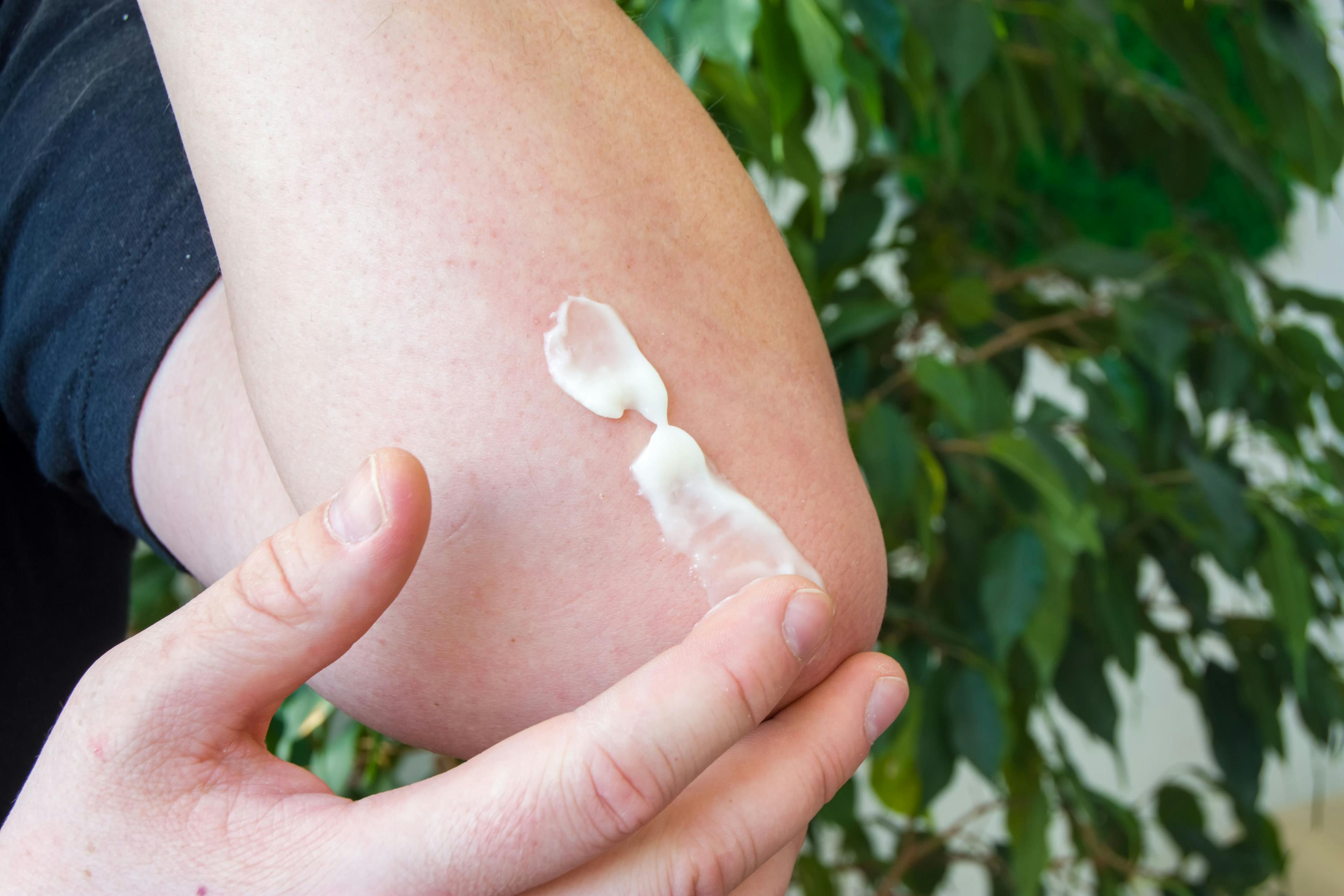- Acne
- Actinic Keratosis
- Aesthetics
- Alopecia
- Atopic Dermatitis
- Buy-and-Bill
- COVID-19
- Case-Based Roundtable
- Chronic Hand Eczema
- Chronic Spontaneous Urticaria
- Drug Watch
- Eczema
- General Dermatology
- Hidradenitis Suppurativa
- Melasma
- NP and PA
- Pediatric Dermatology
- Pigmentary Disorders
- Practice Management
- Precision Medicine and Biologics
- Prurigo Nodularis
- Psoriasis
- Psoriatic Arthritis
- Rare Disease
- Rosacea
- Skin Cancer
- Vitiligo
- Wound Care
Publication
Article
Dermatology Times
Managing AD Pain, Long-Term Therapy Effectively
Author(s):
Adam Friedman, MD, FAAD, outlined his five rules to ensure an effective atopic dermatitis management plan and discussed the current treatments available.
Although generally considered a childhood disease, atopic dermatitis (AD) affects nearly 11% of adults, 10% of whom first experience the skin condition as an adult, Adam Friedman, MD, FAAD, said during a presentation at the ODAC Preconference Sneak Peek Inflammatory Diseases Symposium held virtually in December 2020.1 Friedman is interim chair of the Department of Dermatology, residency program director, and director of the Supportive Oncodermatology Clinic at the George Washington University School of Medicine and Health Sciences in Washington, DC.
“Just because there’s no past history [of disease] at childhood or adolescence doesn’t mean it can’t be atopic dermatitis [in an adult], and a very large subset, roughly a third, have moderate-to-severe disease,” Friedman said.
For many patients, AD’s effects go beyond red, weepy blisters or patches on the skin. In results of an Atopic Dermatitis in America survey, 61% of adults with AD reported pain from their disease.2 Moreover, 33% said they experience pain at least once a week, and 5% reported having pain daily. The findings also showed a correlation between disease severity and pain frequency.
Additionally, the survey found that among 7 disorders examined, AD was associated with an overall higher total impact on quality of life compared with heart disease, food allergies, diabetes, and autoimmune disorders in both men and women.2
“One thing we don’t think or talk about when it comes to atopic dermatitis is pain, and... this is also a very painful condition,” Friedman said. “It’s important to be aware of that and to ask our patients about pain, both from a management standpoint and in terms of the DIY approach that they’re taking at home to not just manage itch but maybe pain, as well.”
In 2014, the American Academy of Dermatology (AAD) came out with guidelines to facilitate diagnosis of AD, which recommended assessing severity by asking patients about itch, sleep, persistence of disease, and the impact on daily activities.3
Although no biomarkers currently exist, Friedman suggested that clinicians use diagnostic criteria for AD; remember the many expressions of erythema, especially when presented on darker skin types, and, when in doubt, biopsy an area that has not been treated for at least two to three weeks.
Friedman also advised employing the AD yardstick to determine treatment and management based on disease severity.4 This method is categorized by nonlesional, mild, moderate, and severe disease. Best practices include reassessing AD control every four to eight weeks for the first three months to determine whether the therapy is working and giving patients a written action plan to promote proper medication use and adherence.
“But no matter where you are, from nonlesional to severe, certain rules always apply, such as basic management and trigger avoidance,” Friedman said. “We need both an active and a long-term management arm.”
SIMPLE STEPS TO MANAGE AD
Physicians can follow Friedman’s five rules to ensure an effective AD management plan, which he calls “Easy E’s.”
- Education: Educate patients, using resources from the National Eczema Association and the American Academy of Dermatology.
- Expectation: Give realistic expectations, for example, when to expect results from treatments or the chronicity and recurrence of disease.
- Encouragement: Encourage patients to maintain treatment through early follow-up visits.
- Enough: Give enough of an effective medication.
- End: End misdiagnoses.
Friedman also gave tips on encouraging trigger avoidance among patients, creating an active and long-term management plan, and using appropriate soaps. He suggested avoiding “true” soaps and paying attention to pH to protect the acid mantle, recommending that patients with AD use moisturizing, soap-free and modified surfactant cleansers.
Bathing education is also vital for AD management, according to Friedman. He prefers that patients take baths rather than showers, especially during flare-ups. There is no standard for the frequency, type, or duration of bathing for patients with AD.
Friedman also recommended generous use of moisturizers with these three ingredients categories: emollients, occlusives, and humectants.
TOPICAL AND SYSTEMIC THERAPIES
An AD management plan might include topical steroids used to suppress inflammation and pruritus, which continues to be the mainstay of treatment, according to Friedman. He recommended that clinicians “hit hard” with strong steroids and then scale down to a maintenance regimen.Starting with a lower-potency steroid that ultimately needs to be used for longer can lead to the expected problems ranging from thinning skin, stretch marks, and telangiectasia to perioral dermatitis and rashes.
If patients hesitate to use topical steroids because of possible adverse effects, Friedman urged discussing those concerns and pointing out that abuse, not proper use, creates problems.
“If excessive amount of greater than 50 g per week is avoided, and treatment vacations are implemented as per the product indication, it appears that superpotent topical steroids may be safe to use over the long haul, without causing systemic effects,” wrote the authors of a 2017 study.5
Topical AD treatments also include calcineurin inhibitors and phosphodiesterase 4 inhibitors.
The systemic therapies azathioprine, cyclosporine, methotrexate, and mycophenolate are currently used off-label for AD. Meanwhile, JAK1 and JAK1/2 inhibitors such as baricitinib, abrocitinib, and upadacitinib are being investigated to treat moderate-to-severe AD and appear to be effective. “It’s all about picking the right regimen for the right patient, not taking a one-size-fits-all [approach],” Friedman said.
Disclosure: Friedman reports working with Aclaris, Allergan, Aveeno, Berg, Biogen, Corbus Pharmaceuticals, Dermira, Eli Lilly and Company, Encore, Exeltis, FSD Pharma, Galderma, Greenway Therapeutix, G&W Laboratories, Hoth Therapeutics, IntraDerm, La Roche-Posay, Loréal, Menlo Therapeutics, MicroCures, Novartis, Pfizer, Sonoma Pharmaceuticals, TruPotency, Valeant, and Zylo Therapeutics.
References:
- Friedman A. Atopic dermatitis update 2021. Presented at: Orlando Dermatology, Aesthetic and Clinical 2021 Preconference Sneak Peek Inflammatory Diseases Symposium; December 3, 2020; virtual.
- SilverbergJI,Gelfand JM, Margolis DJ, et al. Health utility scores of atopic dermatitis in US adults. J Allergy Clin Immunol Pract. 2019;7(4):1246-1252e. doi:10.1016/j.jaip.2018.11.043
- Eichenfield LF, Tom WL, Chamlin, SL, et al. Guidelines of care for the management of atopic dermatitis: section 1. diagnosis and assessment of atopic dermatitis.JAm Acad Dermatol. 2014;70(2):338-351.doi:10.1016/j.jaad.2013.10.010
- Boguniewicz M, Fonacier L, Guttman-Yassky E, Ong PY, Silverberg J, Farrar JR. Atopic dermatitis yardstick: practical recommendations for an evolving therapeutic landscape. Ann Allergy Asthma Immunol.2018:120(1):10-22.e2. doi:10.1016/j.anai.2017.10.039
- Nakamura M, Abrouk M, Zhu H, Farahnik B, Koo J, Bhutani T. Update on the systemic risks of superpotent topical steroids. J Drugs Dermatol. 2017;16(7):643-648.

Newsletter
Like what you’re reading? Subscribe to Dermatology Times for weekly updates on therapies, innovations, and real-world practice tips.


























